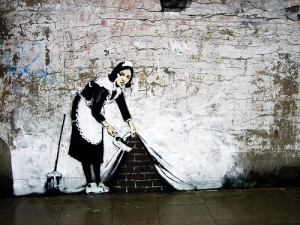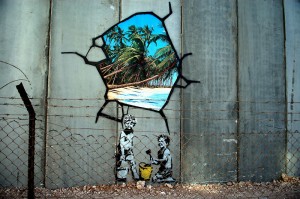Banksy is probably the world’s best-known, anonymous street artist!
Man has always produced ‘Street Art’, beginning with primitive cave paintings. Our modern notion of the movement began in the late 1960s when a new generation of young artists began using cities such as New York and Paris as their canvas and in the beginning of the 1990s the Berlin Wall became a major backdrop for the art. Over this period the idea of street art as a movement, rather than mindless graffiti, emerged. This change in attitude has been accompanied by the development of digital social media. Street art has become a method of getting a social commentary across to a worldwide audience in a few hours, rather than just an interesting picture on a wall seen by a limited, local audience.
Banksy is one of the most controversial anonymous street artists, known for his satirical wall stencils. His real identity has remained a mystery to admirers, even as his fame has grown since the late 1990s. Time magazine selected him as one of the most influential people in the world in 2010, but still the picture he supplied of himself showed him with a paper bag over his head. The main reason for Banksy’s hidden identity is that most of his work is displayed illegally, so if found he could be prosecuted for vandalism. There is much public appreciation for his work, however the secretive nature of the art arguably adds to its popularity.
Banksy’s real name is believed to be Robert Banks, born near Bristol in 1974. He first became involved in producing graffiti around the Bristol area in the late 1980s, at the age of 14. The longer an image took to produce, the higher the chance of being arrested for vandalism. Banksy began to cut out stencils at home of pictures and phrases he wanted to use, realizing that he wasn’t quick enough to create large spray-painted works of art without.
It is thought that the young Banksy experienced difficulties while growing up and was expelled from school, afterwards drifting into petty crime, it is possible that he spent some time in prison. At some point he left Bristol and moved to London. By the year 2000, his artworks had become a cult phenomenon in London.
The most famous wall stencils done by Banksy include kissing London policeman and a trompe l’oeil of a hotel maid sweeping dust from the street under a brick wall.

Banksy’s images are often satirical and cover topics from contemporary politics and culture. He combines freehand painting with a distinctive use of stencils. His art has appeared beyond London and the UK, in cities including New York and Los Angeles. He has held conventional exhibitions of his work in the UK and the USA. The Museum of Modern Art in Manhattan has his work in its permanent collection.
Banksy has been quoted as saying. “There’s a whole new audience out there, and it’s never been easier to sell one’s art. You don’t have to go to college, drag round a portfolio, mail off transparencies to snooty galleries or sleep with someone powerful, all you need is a few ideas and a broadband connection. This is the first time the essentially bourgeois world of art has belonged to the people. We need to make it count.”
Banksy continues to court controversy, both in his style of artwork and where it is executed. He went to Palestine and stenciled on the wall that the Israeli government had built around the occupied Palestinian territories, one of the works featuring young people digging to get to the other side. Banksy stated. “The Israeli government is building a wall surrounding the occupied Palestinian territories. It stands three times the height of the Berlin Wall and will eventually run for over 700km – the distance from London to Zurich. The wall is illegal under international law and essentially turns Palestine into the world’s largest open prison. It also makes it the ultimate activity holiday destination for graffiti writers.”
References:
Gompertz, W. (2012). Art Now: Fame and Fortune 1988-2008-Today. In: Gompertz, W What are you looking at? 150 years of modern art in the blink of an eye. London: Penguin Group. p366-395.
Fig. 1. Banksy, (2004), Banksy Kissing Coppers Police [ONLINE]. Available at:http://www.stencilrevolution.com/banksy-art-prints/banksy-kissing-coppers-police/[Accessed 06 March 14].
Fig. 2. Banksy, (2004), Maid [ONLINE]. Available at: http://timeisart.org/?p=454 [Accessed 06 March 14].
Fig. 3.Banksy, (2005), West Bank [ONLINE]. Available at: http://electronicintifada.net/content/well-known-uk-graffiti-artist-banksy-hacks-wall/5733 [Accessed 06 March 14].


